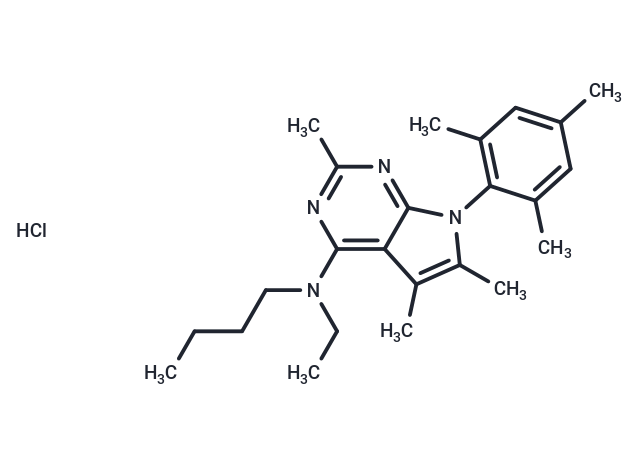Shopping Cart
- Remove All
 Your shopping cart is currently empty
Your shopping cart is currently empty

Antalarmin hydrochloride is an antagonist of corticotropin-releasing factor 1(CRF1). Antalarmin hydrochloride produces anti-inflammatory effects and suppresses stress-induced gastric ulceration related to irritable bowel syndrome.

| Pack Size | Price | Availability | Quantity |
|---|---|---|---|
| 5 mg | $58 | In Stock | |
| 10 mg | $93 | In Stock | |
| 25 mg | $187 | In Stock | |
| 50 mg | $279 | In Stock | |
| 100 mg | $397 | In Stock |
| Description | Antalarmin hydrochloride is an antagonist of corticotropin-releasing factor 1(CRF1). Antalarmin hydrochloride produces anti-inflammatory effects and suppresses stress-induced gastric ulceration related to irritable bowel syndrome. |
| Molecular Weight | 415.02 |
| Formula | C24H35ClN4 |
| Cas No. | 220953-69-5 |
| Smiles | Cl.CCCCN(CC)c1nc(C)nc2n(c(C)c(C)c12)-c1c(C)cc(C)cc1C |
| Relative Density. | no data available |
| Storage | Powder: -20°C for 3 years | In solvent: -80°C for 1 year | Shipping with blue ice. | |||||||||||||||||||||||||
| Solubility Information | DMSO: 11.7 mg/mL (28.2 mM), Sonication is recommended. | |||||||||||||||||||||||||
Solution Preparation Table | ||||||||||||||||||||||||||
DMSO
| ||||||||||||||||||||||||||

Copyright © 2015-2025 TargetMol Chemicals Inc. All Rights Reserved.